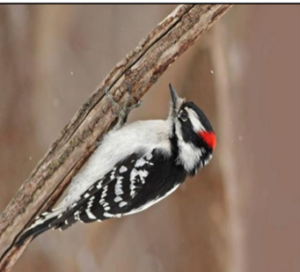Conservation Corner
Conservation Corner is a weekly article produced by the Forest County Land &Water Conservation Department. For more information contact Steve Kircher, County Conservationist-Land Information/GIS Director at 715-478-1387 or by e-mail at .
Downy vs. Hairy Woodpeckers – Identification Tips
The other morning, I was enjoying my coffee with the birds. There was a woodpecker on one of the suet feeders and I identified it as a Downy woodpecker. Well, one of my wife’s daycare students let me know that it wasn’t a Downy, but a Hairy Woodpecker and proceeded to show me in the bird book.
Hairy woodpeckers have the same coloration but are larger than downies. They have spotted back and wings and white underparts. They are 9-1/4 inches long, with a 15-inch wingspan. Hairy woodpeckers are about one-third larger than downy woodpeckers, close to the size of a robin. Its chisel-shaped bill is prominent, about the same length as its head. Its coloring varies across North America, and at times it appears to be stained with brown watercolors and has less spotting.
The female lacks the red patch on the back of its head. Hairy woodpeckers nest in a cavity excavated by both sexes. The female usually lays four white eggs. Their diet mainly consists of insects, larvae of woodborers, fruit and nuts. Attract hairy woodpeckers with feeders full of suet, peanuts, peanut butter and black-oil sunflower seeds, especially in the winter. These birds prefer forests, but may move to open country in fall and winter. You can see them year-round throughout much of the United States.
Affectionately called ‘downies’, these woodpeckers might easily be mistaken for a nuthatch clinging to the side of a feeder, or a chickadee, with its bold black-and-white coloring.
Look for a bird slightly smaller than a robin with a white belly and back, black wings with white spots, and white facial stripes against a mostly black head.
Downies measure 6-1/2 inches long with a wingspan of 12 inches. A practiced eye can tell them apart by the size of their beaks, too. The hairy’s beak is almost as long as its head, while downies’ beaks are shorter, comparatively.
Males and females can be told apart by a red marking on the back of the male’s head. Downy woodpeckers form pairs very early in the season. Courtship begins toward the end of winter. Both sexes drum on trees to claim their territory and indicate they’re ready to mate.
Listen for this rhythmic sound as early as January. They also call out to each other in whinnying, high-pitched notes that are accented by excited ‘piks’. Once paired, the partners dig out a cavity in a dead tree for their nest or use a woodpecker nesting box. The female lays four to five white eggs.
Their diet mainly consists of insects, caterpillars, berries and nuts. Downies snack on insects that harm trees, like bark beetles and apple borers, and are drawn to feeders in many locations, both developed and rural. Hang their favorite treats, suet and peanut butter, to attract them. In warmer months when suet spoils easily, black oil sunflower seeds, millet and peanuts are suitable meals.
Like most woodpeckers, downies use their exceptionally long tongues to scavenge. Downies’ small size also gives them another advantage over their fellow woodpeckers. They are adept at climbing up large tree trunks and branches, but they also glean bugs and grubs from weeds, grasses and thin twigs that can support their 1-ounce frames.
They reside in most of the United States and Canada, with the exception of the far north and the driest zones in the Southwest. These cheery checkered birds have expanded their ranges in the last few years, despite a changing, more urban, environment. You might see them in any open wooded area, including parks and backyards.



